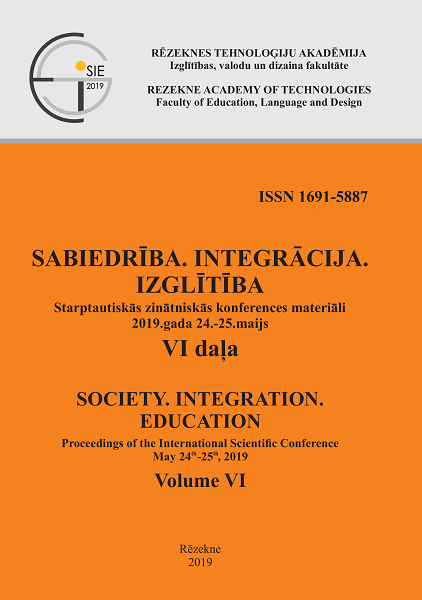CRIMINOLOGICAL ASPECTS OF FAMILY RELATIONS
DOI:
https://doi.org/10.17770/sie2019vol6.3759Keywords:
family, role of family, family criminologyAbstract
The dynamic variability of the modern world determines not only the need to adapt but also the ability to preserve and maintain the values of separate culture. Over the centuries, family is considered to be one of the core values. Family interaction with the society is undeniable. The family is the foundation of any society and the future of the state. Today's new socio-economic situation has an impact on the emotional atmosphere, quality and relationships within the family. Criminological research in family relationships is a complex problem, its environment and circumstances are an important factor in the individual's socialization. The role of the family is equally important both in the process of proper behavioural shaping and in the production of directed behaviour. The article provides an insight into the content of the studies of family criminology.
The aim of the article is to describe the criminological framework of family relations based on special literature, research and practice showing the framework of family criminology. Theoretical guidelines, special literature, views and opinions of Latvian and foreign specialists have been analysed in order to assess the criminological aspects of the phenomenon.
The author concludes that the knowledge of family criminology is useful, effective, concrete and practically feasible for the criminological studies of the family institute. This approach has a multi-sectoral nature.
References
Albercht, T. L., & Adelman, M. B. (1987). Communicating social support. Thousand Oaks, CA, US: Sage Publications, Inc.
Alternatīvas cietumam: darbs ar riska bērniem pašvaldībās. (2003). Rīga: VNDP.
Ball, R. A., Culler, F. T., & Lilly, R. J. (2015). Criminological Theory: Context and Consequences. Thousand Oaks, CA, US: Sage, Publication, Inc.
Bērni Latvijā (2013). Rīga: Latvijas Republikas Centrālās statistikas pārvalde.
Bērnu – noziedzīgo nodarījumu upuru – tiesiskā un sociālā aizsardzība (2002). Rīga: Tieslietu ministrijas Kriminoloģisko pētījumu centrs.
Bērnu tiesību aizsardzības likums. Latvijas Republikas likums. Latvijas Vēstnesis 199/200 (1260/1261), 08.07.1998.
Broka, A., Kūle, L., & Kūla, E. (2014). Sociālā cilvēkdrošība: bērni un ģimenes ar bērniem Latvijā. Rīga: LU Akadēmiskais apgāds.
Ceplis, D., Liepiņa, L., Prišpetjeva, J., Sūniņa, V., & Vilks, A. (2001). Bērns un kriminalitāte. Metodiski informatīvo materiālu krājums. Rīga: izdevniecība RaKa.
Dobelniece, S., Millere, J. & Salmane-Kulikovska, I. (2015). Situation Analysis of Social Risk Families with Children in Latvia. Proceedings of the 2015 International Conference “Economic science for rural development”, No. 40, 141-150.
Dressler, J. (2002). Encyclopedia of Crime & Justice: 4. New York: Macmillan Reference.
Farrington, D. P., & Welsh, B. C. (2007). Saving Children from a Life of Crime: Early Risk Factors and Effective Interventions. Oxford, UK: Oxford University Press.
Girgensone, B., & Mihailovs, I. J. (2016). Terminu skaidrojošā vārdnīca. Ģimenes un bērnu tiesībās. Rīga: SIA „Drukātava”.
Ģimenes valsts politikas pamatnostādnes 2011.-2017.gada. Retrieved from: www.lm.gov.lv/upload/berns_gimene/lmpamn_200111_gvp.pdf
Ja tu ciet no partnera vardarbības, tu esi spējīga to pārtraukt! (2007). Informatīvs materiāls. Rīga.
Mūrnieks, E. (2003). Mācību materiāli un vingrinājumi socioloģijā. Rīga: RTU izdevniecība.
Karpova, Ā. (2006). Ģimenes psiholoģija. Rīga: izdevniecība Raka.
Kas mūsdienās ir ģimene? Retrieved from: www.rsu.lv/
Kaslow, F. W. (1981). Profile of the Healthy, Family. Interaction, 4, (1/2),1-15.
Kipāne, A. (2015). Seksuālās vardarbības kriminoloģiskās problēmas. Promocijas darbs. Rīga: Rīgas Stradiņa universitāte.
Kristapsone, S. (2005) Pusaudžu un jauniešu sociāli demogrāfiskās un ekonomiskās atšķirības pilnās un nepilnās ģimenēs. Latvijas Universitātes raksti 2005, 689.sējums: Ekonomika, IV, 148-160.
Latvijas Republikas Satversme. Latvijas Vēstnesis, 43, 01.07.1993.
Ministru kabineta 2011. gada 5. oktobra rīkojums Nr.504 „Par Sabiedrības veselības pamatnostādnēm 2011.−2017.gadam.”
Patterson, G. R., De Baryshe, B., & Ramsey, R. A. (1990). Developmmental Perspective on Antisocial Behavior. American Psychologists, 44, 329-335.
Pētījums par Latvijas jauniešu bērnībā gūto nelabvēlīgo pieredzi. Pētījuma kopsavilkums. (2011). Retrieved from:
http://www.bernskacietusais.lv/files/jauniesu_berniba_guto_vardarbibas_pieredzi.pdf
Riska faktoru novērtēšanas kritēriji nelabvēlīgajās ģimenēs. Retrieved from: www.lm.gov/riska-fakt-nelabv-gim
Sociālā darba terminoloģijas vārdnīca. (2000). Rīga: SDSPA.
Škapars, R. (2010). Ekonomikas būtība un priekšmets. Teorija (e-grāmata). Retrieved from: http://profizgl.lu.lv/mod/book/view.php?id=610
Shestakov, D. A. (1999). Legislative solutions of conflicts in Russia in connection with problems of family criminology. In I.Sagel-Grande & M.V.Polak (Ed). Models of Conflict Resolution (157-166). Antwerpen-Apeldoorn: Institute of Legal Studies.
Taylor, I. (2013). The New Criminology: For a Social Theory of Deviance. Routledge.
Van de Rakt, M., Nieuwbeerta, P., & de Graaf, N. D. Like Father, Like Son. The Relationships between Conviction Trajectories of Fathers and their Sons and Daughters. Retrieved from: http://ics.uda.ub.rug.nl/FILES/root/Articles/2008/RaktMvd-LikeFather/RaktMvd-LikeFather-2008.pdf
Vaitiekus E., & Šakalyte, D. (2016). Social mobility of families risk. Proceedings of the International Scientific Conference. Society. Integration. Education. Volume III, May 27th-28th, pp. 402-410.
Vardarbība un veselība. Ziņojums par stāvokli 2007. Retrieved from: http://www.lm.gov.lv/upload/berns_gimene/bernu_tiesibas/vardarbiba_veseliba.pdf
Walklate, S. (2007). Understanding Criminology: Current Theoretical Debates. New York, Open University Press.
World Health Organization definition of Health. Retrieved from: https://www.who.int/about/mission/en/
Зеркин, Д. (2007). Основы конфликтологии: Курс лекций. Ростов-н/Д: Феникс.
Криминология – XX век (2000) / под ред. проф. В. Н. Бурлакова, проф. В. П. Сальникова. Санкт–Петербург: Издательство “Юридический центр Пресс”.
Мясникова, К. А. (2012). Преступное насилие в криминофамилистике. Общество и Право, №2 (39), 147-152. Retrieved from: http://cyberleninka.ru/article/n/prestupnoe-nasilie-v-kriminofamilistike
Шестаков, Д. А. (1980). Введение в криминологию семейных отношений. Ленинград: ЛГУ.
Шестаков, Д. A. (2003). Ceмейная криминолoгия: криминофамилистика. Санкт-Петербург: Юридический центр.
Шестаков, Д. А. (2006). Криминогенные законы и криминологическое законодательство. Противодействие преступности в изменяющемся мире. Учебник. Санкт–Петербург: Юрид. Центр Пресс.






